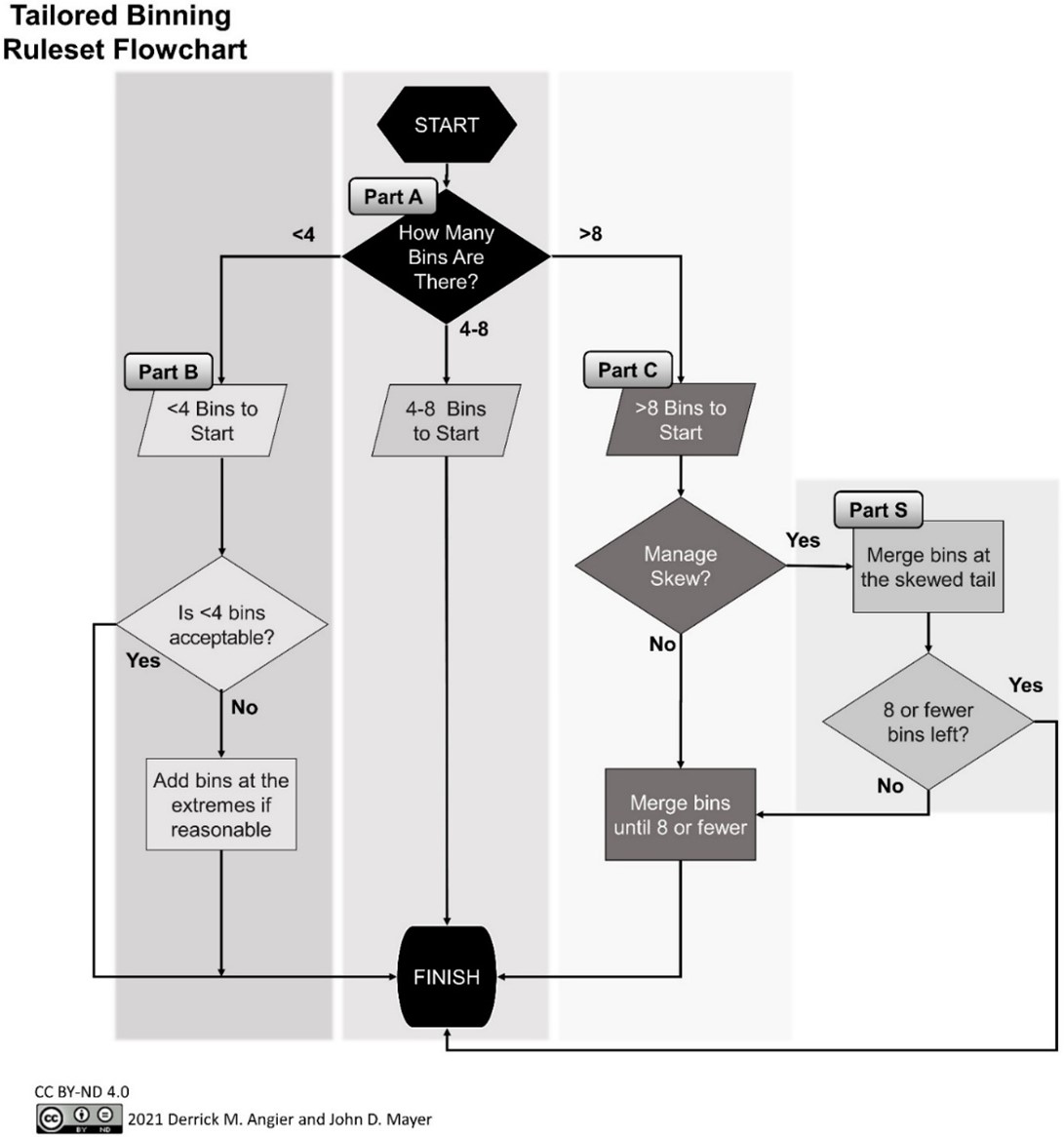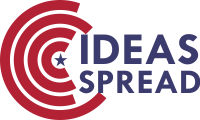A Comparison of Methods for Binning Responses to Open-Ended Survey Items About Everyday Events: A New Tailored-Binning Approach
Abstract
Psychologists and other researchers employ diverse types of surveys and survey items. Lifespace-type items include questions about a person’s external life conditions and activities, for example, “How many hours did you spend playing video games last week?” and elicit countable responses, for example, 0 hours, < 1 hour, 1-2 hours, 3-5 hours, etc., where the response intervals are referred to as bins. We report on a procedure for creating tailored bins for participants and compare it to two other binning approaches in an original and a replication study (Ns = 263 and 246). The Tailored binning approach developed here is highly structured, but, for convenience, can also be applied in less formal fashions. In the structured form focused on here, it compares favorably with alternative approaches such as Equal Percentage and Equal Interval methods. The pros and cons of each method are described in the Discussion and recommendations are provided.
References
Angier, D. M. (2025). Innocent Fun or Unhealthy Habit: What’s Your Game? Personality and Engagement with Video Games [Manuscript in preparation].
Angier, D. M., & Mayer, J. D. (2025). Technical Supplement for “A Comparison of Methods for Binning Responses to Open- Ended Survey Items About Everyday Events: A New Tailored-Binning Approach.” https://osf.io/v5ty6
Borgers, N., Hox, J., & Sikkel, D. (2004). Response Effects in Surveys on Children and Adolescents: The Effect of Number of Response Options, Negative Wording, and Neutral Mid-Point. Quality & Quantity, 38, 17–33. https://doi.org/10.1023/B:QUQU.0000013236.29205.a6
Brackett, M. A., & Mayer, J. D. (2006). The life space: A framework and method to describe the individual’s external traits. Imagination, Cognition and Personality, 26(1–2), 3–41. https://doi.org/10.2190/8380-1676-H338-N217
Bryan, V. (2023). Knowing Me, Knowing You: The Role of Personal Intelligence in Romantic Relationship Conflict Communication. Doctoral Dissertations. https://scholars.unh.edu/dissertation/2774
Buss, D. M., & Craik, K. H. (1983). The Act Frequency Approach to Personality. Psychological Review, 90(2), 105–126. https://doi.org/10.1037/0033-295X.90.2.105
Chapman, B. P., & Goldberg, L. R. (2017). Act-frequency signatures of the Big Five. Personality and Individual Differences, 116, 201–205. https://doi.org/10.1016/j.paid.2017.04.049
Current Population Survey: 2019 ASEC Technical Documentation. (2020). Washington: U.S. Census Bureau. Retrieved from https://www2.census.gov/programs-surveys/cps/techdocs/cpsmar19.pdf
Dash, R., Paramguru, R. L., & Dash, R. (2011). Comparative Analysis of Supervised and Unsupervised Discretization Techniques. International Journal of Advances in Science and Technology, 2(3), 29–37.
De Brouwer, P. (2021). Data Binning. In The Big R‐Book: From Data Science to Learning Machines and Big Data (1st ed., pp. 343–361). Wiley. https://doi.org/10.1002/9781119632757
Delacre, M., Leys, C., Mora, Y. L., & Lakens, D. (2019). Taking Parametric Assumptions Seriously: Arguments for the Use of Welch’s F-test instead of the Classical F-test in One-Way ANOVA. International Review of Social Psychology, 32(1), 13. https://doi.org/10.5334/irsp.198
Doane, D. P. (1976). Aesthetic Frequency Classifications. The American Statistician, 30(4), 181–183. JSTOR. https://doi.org/10.2307/2683757
Freedman, D., & Diaconis, P. (1981). On the histogram as a density estimator:L2 theory. Zeitschrift Für Wahrscheinlichkeitstheorie Und Verwandte Gebiete, 57(4), 453–476. https://doi.org/10.1007/BF01025868
Ivcevic, Z. (2007). Artistic and Everyday Creativity: An Act-Frequency Approach. The Journal of Creative Behavior, 41(4), 271–290. https://doi.org/10.1002/j.2162-6057.2007.tb01074.x
Ivcevic, Z., & Mayer, J. D. (2009). Mapping dimensions of creativity in the life-space. Creativity Research Journal, 21(2–3), 152–165. https://doi.org/10.1080/10400410902855259
Knuth, K. H. (2013). Optimal Data-Based Binning for Histograms. arXiv:Physics. http://arxiv.org/abs/physics/0605197v2
Kotsiantis, S., & Kanellopoulos, D. (2006). Discretization Techniques: A recent survey. GESTS International Transactions on Computer Science and Engineering, 32(1), 47–58.
Lavielle, M., & Bleakley, K. (2011). Automatic data binning for improved visual diagnosis of pharmacometric models. Journal of Pharmacokinetics and Pharmacodynamics, 38(6), 861–871. https://doi.org/10.1007/s10928-011-9223-3
Mael, F. A. (1991). A Conceptual Rationale for the Domain and Attributes of Biodata. Personnel Psychology, 44(4), 763–792. https://doi.org/10.1111/j.1744-6570.1991.tb00698.x
Mael, F. A., & Hirsch, A. C. (1993). Rainforest Empiricism and Quasi’-Rationality: Two Approaches to Objective Biodata. Personnel Psychology, 46(4), 719–738. https://doi.org/10.1111/j.1744-6570.1993.tb01566.x
Mayer, J. D., & Bryan, V. M. (2024). On Personality Measures and Their Data: A Classification of Measurement Approaches and Their Recommended Uses. Personality and Social Psychology Review, 28(3), 325-345. https://doi.org/10.1177/10888683231222519
Mayer, J. D., Carlsmith, K. M., & Chabot, H. F. (1998). Describing the Person’s External Environment: Conceptualizing and Measuring the Life Space. Journal of Research in Personality, 32(3), 253–296. https://doi.org/10.1006/jrpe.1998.2220
Mayer, J. D., Caruso, D. R., & Panter, A. T. (2023). Personal Intelligence Lifespace Inventory (PILSI) Combined Technical Report. Retrieved from https://osf.io/3ea4r/
Mayer, J. D., Caruso, D. R., & Panter, A. T. (2024). Lifespace Patterns of College Students High and Low in Personal Intelligence. Collabra: Psychology. https://doi.org/10.1525/collabra.90222
Myers, J. L., Well, A. D., & Lorch, R. F. Jr. (2013). Research Design and Statistical Analysis: Third Edition. Routledge.
Paunonen, S. V. (2003). Big Five factors of personality and replicated predictions of behavior. Journal of Personality and Social Psychology, 84(2), 411–424. https://doi.org/10.1037/0022-3514.84.2.411
Perkey, H., Sinclair, S. J., Blais, M., Stein, M. B., Neal, P., Pierson, A. D., & Slavin-Mulford, J. (2018). External validity of the Psychiatric Diagnostic Screening Questionnaire (PDSQ) in a clinical sample. Psychiatry Research, 261, 14–20. https://doi.org/10.1016/j.psychres.2017.12.011
Prieto Curiel, R., Cabrera Arnau, C., Torres Pinedo, M., González Ramírez, H., & Bishop, S. R. (2020). A continuous binning for discrete, sparse and concentrated observations. MethodsX, 7, 100709. https://doi.org/10.1016/j.mex.2019.10.020
Scott, D. W. (1979). On optimal and data-based histograms. Biometrika, 66(3), 605–610. https://doi.org/10.1093/biomet/66.3.605
Semega, J., Kollar, M., Creamer, J., & Mohanty, A. (2020). Income and Poverty in the United States: 2018. Retrieved from https://www.census.gov/content/dam/Census/library/publications/2019/demo/p60-266.pdf
Simms, L. J., Zelazny, K., Williams, T. F., & Bernstein, L. (2019). Does the number of response options matter? Psychometric perspectives using personality questionnaire data. Psychological Assessment, 31(4), 557–566. https://doi.org/10.1037/pas0000648
Soto, C. J., & John, O. P. (2017). The next Big Five Inventory (BFI-2): Developing and assessing a hierarchical model with 15 facets to enhance bandwidth, fidelity, and predictive power. Journal of Personality and Social Psychology, 113(1), 117–143. https://doi.org/10.1037/pspp0000096
Strevens, M. (2020). The Knowledge Machine: How Irrationality Created Modern Science. Liveright.
Sturges, H. A. (1926). The Choice of a Class Interval. Journal of the American Statistical Association, 21(153), 65–66. https://doi.org/10.1080/01621459.1926.10502161
Sulastri, A., Handoko, M., & Janssens, J. M. A. M. (2015). Grade point average and biographical data in personal resumes: Predictors of finding employment. International Journal of Adolescence and Youth, 20(3), 306–316. https://doi.org/10.1080/02673843.2014.996236
Tukey, J. W. (1962). The Future of Data Analysis. The Annals of Mathematical Statistics, 33(1), 1–67. https://doi.org/10.1214/aoms/1177704711


This work is licensed under a Creative Commons Attribution 4.0 International License.
Copyright for this article is retained by the author(s), with first publication rights granted to the journal.
This is an open-access article distributed under the terms and conditions of the Creative Commons Attribution license (http://creativecommons.org/licenses/by/4.0/).









1.png)














